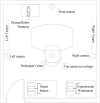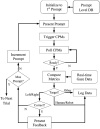A step towards developing adaptive robot-mediated intervention architecture (ARIA) for children with autism
- PMID: 23221831
- PMCID: PMC3860752
- DOI: 10.1109/TNSRE.2012.2230188
A step towards developing adaptive robot-mediated intervention architecture (ARIA) for children with autism
Abstract
Emerging technology, especially robotic technology, has been shown to be appealing to children with autism spectrum disorders (ASD). Such interest may be leveraged to provide repeatable, accurate and individualized intervention services to young children with ASD based on quantitative metrics. However, existing robot-mediated systems tend to have limited adaptive capability that may impact individualization. Our current work seeks to bridge this gap by developing an adaptive and individualized robot-mediated technology for children with ASD. The system is composed of a humanoid robot with its vision augmented by a network of cameras for real-time head tracking using a distributed architecture. Based on the cues from the child's head movement, the robot intelligently adapts itself in an individualized manner to generate prompts and reinforcements with potential to promote skills in the ASD core deficit area of early social orienting. The system was validated for feasibility, accuracy, and performance. Results from a pilot usability study involving six children with ASD and a control group of six typically developing (TD) children are presented.
Figures







Similar articles
-
Robot-Mediated Imitation Skill Training for Children With Autism.IEEE Trans Neural Syst Rehabil Eng. 2016 Jun;24(6):682-91. doi: 10.1109/TNSRE.2015.2475724. Epub 2015 Sep 3. IEEE Trans Neural Syst Rehabil Eng. 2016. PMID: 26353376 Free PMC article.
-
Investigating tactile event recognition in child-robot interaction for use in autism therapy.Annu Int Conf IEEE Eng Med Biol Soc. 2011;2011:5347-51. doi: 10.1109/IEMBS.2011.6091323. Annu Int Conf IEEE Eng Med Biol Soc. 2011. PMID: 22255546
-
Design of a virtual reality based adaptive response technology for children with autism.IEEE Trans Neural Syst Rehabil Eng. 2013 Jan;21(1):55-64. doi: 10.1109/TNSRE.2012.2218618. Epub 2012 Sep 27. IEEE Trans Neural Syst Rehabil Eng. 2013. PMID: 23033333 Free PMC article.
-
Computer- and Robot-Assisted Therapies to Aid Social and Intellectual Functioning of Children with Autism Spectrum Disorder.Medicina (Kaunas). 2019 Aug 5;55(8):440. doi: 10.3390/medicina55080440. Medicina (Kaunas). 2019. PMID: 31387274 Free PMC article. Review.
-
ROBOT - Assisted Rehabilitation in Patients After Stroke.Stud Health Technol Inform. 2014;202:316. Stud Health Technol Inform. 2014. PMID: 25000084 Review. No abstract available.
Cited by
-
Design of an Autonomous Social Orienting Training System (ASOTS) for Young Children With Autism.IEEE Trans Neural Syst Rehabil Eng. 2017 Jun;25(6):668-678. doi: 10.1109/TNSRE.2016.2598727. IEEE Trans Neural Syst Rehabil Eng. 2017. PMID: 28644796 Free PMC article.
-
Music and Sound-Based Intervention in Autism Spectrum Disorder: A Scoping Review.Psychiatry Investig. 2022 Aug;19(8):626-636. doi: 10.30773/pi.2021.0382. Epub 2022 Aug 24. Psychiatry Investig. 2022. PMID: 36059051 Free PMC article.
-
Brief Report: Development of a Robotic Intervention Platform for Young Children with ASD.J Autism Dev Disord. 2015 Dec;45(12):3870-6. doi: 10.1007/s10803-014-2334-0. J Autism Dev Disord. 2015. PMID: 25503680 Free PMC article.
-
Effectiveness of Video Self-Modeling in Teaching Unplugged Coding Skills to Children with Autism Spectrum Disorders.Behav Sci (Basel). 2025 Feb 26;15(3):272. doi: 10.3390/bs15030272. Behav Sci (Basel). 2025. PMID: 40150166 Free PMC article.
-
Can Robotic Interaction Improve Joint Attention Skills?J Autism Dev Disord. 2015 Nov;45(11):3726-34. doi: 10.1007/s10803-013-1918-4. J Autism Dev Disord. 2015. PMID: 24014194 Free PMC article.
References
-
- Diagnostic and Statistical Manual of Mental Disorders: Quick Reference to the Diagnostic Criteria DSM-IV-TR. Am. Psychiatric Pub.; Washington, DC, USA: 2000.
-
- Baio JA. Prevalence of Autism Spectrum Disorders—Autism and Developmental Disabilities Monitoring Network. Washington, DC, USA; 2012. 14 Sites, United States, 2008: National Center on Birth Defects and Developmental Disabilities. Centers Disease Control Prevent., U.S. Dept. Health Human Ser.
-
- Prevalence of autsim spectrum disorders-ADDM Network Centers for Disease Control Prevent. Washington, DC, USA: 2009. MMWR Weekly Rep. 58.
-
- Autism Spectrum Disorders Prevalence Rate. Autism Speaks Center Disease Control; Washington, DC, USA: 2011.
-
- Interagency Autism Coordinating Committee Strategic Plan for Autism Spectrum Disorder Research U.S. Dept. Health Human Services. 2009 [Online]. Available: http://iacc.hhs.gov/strategic-plan/2009/
Publication types
MeSH terms
Grants and funding
LinkOut - more resources
Full Text Sources
Other Literature Sources
Miscellaneous

